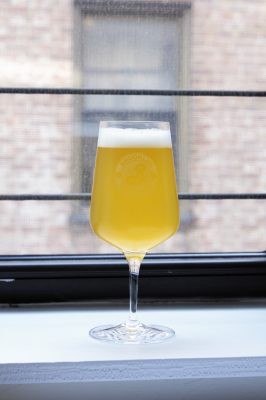I’ve had a lot of fun over the past couple of years maintaining a mixed culture of Sacc, Brett, and Lacto; and using it to make some pretty nice tart, funky saisons. The culture started its life as a blend of cultures grown from Saison DuPont bottles, The Yeast Bay’s Amalgamation Brett Blend, and White Labs Lacto Brevis. Over the 6+ generations I’ve used the culture, it continues to produce great beers that have an awesome Brett fruitiness that plays especially nicely with big punchy dry hops. Initially, I was very concerned that too much drift would occur in the blend of different organisms, but the culture has remained remarkably consistent in its fermentation characteristics—something I hope stays true for many more generations.
One thing that I’ve always known is that this mixed culture reacts differently to varying levels of kettle hopping, especially in terms of lactic acid production. I’ve observed this anecdotally over several batches, but never completed a side-by-side experiment. For fun, I decided to actually test the culture on two very similar worts to see just how different the beers would become.
For starters, I used the hoppy saison recipe that has turned out quite good in the past.
Base Saison Recipe
Specifications:
Size: 3.25 gal
Efficiency: 69%
Original Gravity: 1.050
Color: 4.45 SRM
Bitterness: 0 IBUs
Malt Bill:
5 lbs (71.4%) Weyermann Pilsner Malt
1 lb (14.3%) Flaked Oats
1 (14.3%) Weyermann Rye Malt
Mash Profile:
150°F – 60m
170°F – 5m
Water Treatment:
Extremely Soft NYC Water
4g Gypsum (to mash)
Kettle Additions:
0.25 ea Whirlfloc Tablets (Irish moss) – 15m
0.25 tsp Wyeast Nutrient – 10m
Yeast:
Mixed Saison Culture
The Experiment
Two identical batches using the above recipe were brewed back-to-back. The key difference is that Batch 1 received hopping at the end of the boil in the whirlpool, whereas Batch 2 did not and was instead given a post-fermentation dry hop. Other analytic differences between the two batches are outlined below.
Batch 1 – Whirlpool Hopped at End of Boil
Hopping:
2 oz. Mosaic (12.3% AA) – Whirlpool 15 m
4 oz. Azacca (10.3% AA) – Whirlpool 15m
Attenuation: 76%
Terminal Gravity: 1.012
Alcohol: 5%
pH: 3.27
Batch 2 – Dry Hopped Post Fermentation
Hopping:
No hops before fermentation.
2 oz. Mosaic (12.3% AA) – Dry Hop 2 Days
2 oz. Azacca (10.3% AA) – Dry Hop 2 Days
Attenuation: 80%
Terminal Gravity: 1.010
Alcohol: 5.24%
pH: 2.71
The Results
Both batches of beer turned out extremely unique (and quite delicious). I am guessing most people would be surprised to find out that the two beers were produced from the same mixed culture and remarkably similar recipes.
As expected, the whirlpool hopped beer developed significantly less acidity than the batch that was not hopped prior to fermentation. Tasting the beers, it is very obvious that the beer that did not receive kettle hopping is significantly more sour than the beer that was hopped in the whirlpool. That said, the whirlpool hopped beer did develop a light lactic tartness that is consistent with its 3.27 finishing pH.
It is also interesting to note that the kettle-hopped beer attenuated slightly less than the beer that only received a dry hop. I would have thought the opposite would have occurred with the lower pH inhibiting attenuation by the Brett / Sacc in the culture. The difference of .02 SG is probably not significant enough to draw any real conclusions, but it is an interesting anecdote.
The sensory aspects of the two beers are strikingly different. The beer that received kettle hopping ultimately developed a much higher level of the traditional flavors attributable to the Brett in the mixed culture (funk, overripe fruit) whereas the Lacto-heavy dry-hopped beer is much more two note with lots of acid and a significant fruity, dry hop character. It is unclear to me why the kettle-hopped beer developed more Brett character and it will be interesting to see if the dry-hopped beer eventually develops these characteristics. I hope to keep some of the beer around to see if the flavors ultimately converge at a single point or whether they continue to remain two incredibly different beers.
UPDATE: The dry-hopped version of this beer placed first in Category 28, American Wild Ale at the 2016 Joint Novembeerfest / Puget Sound Pro-Am.

